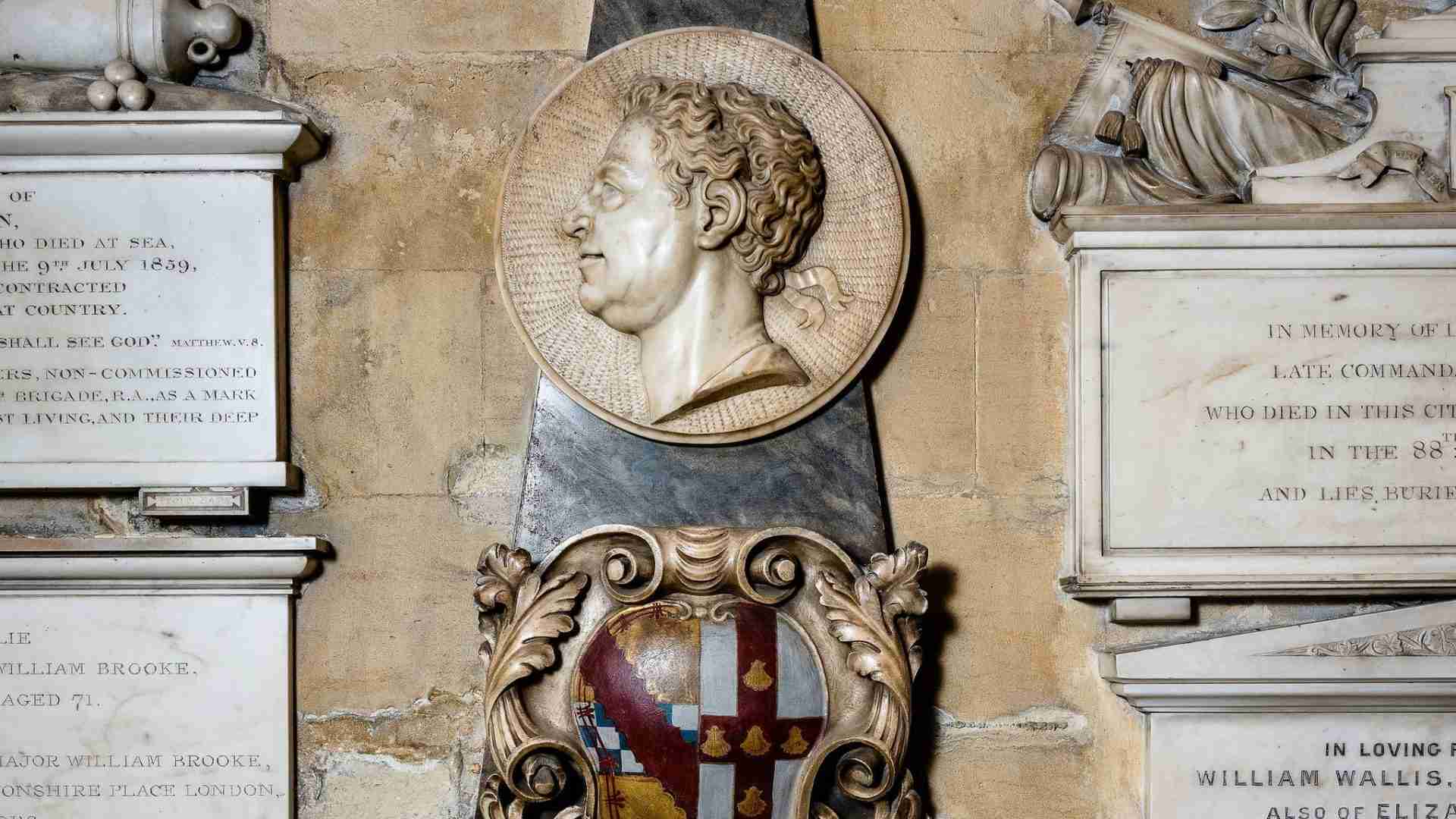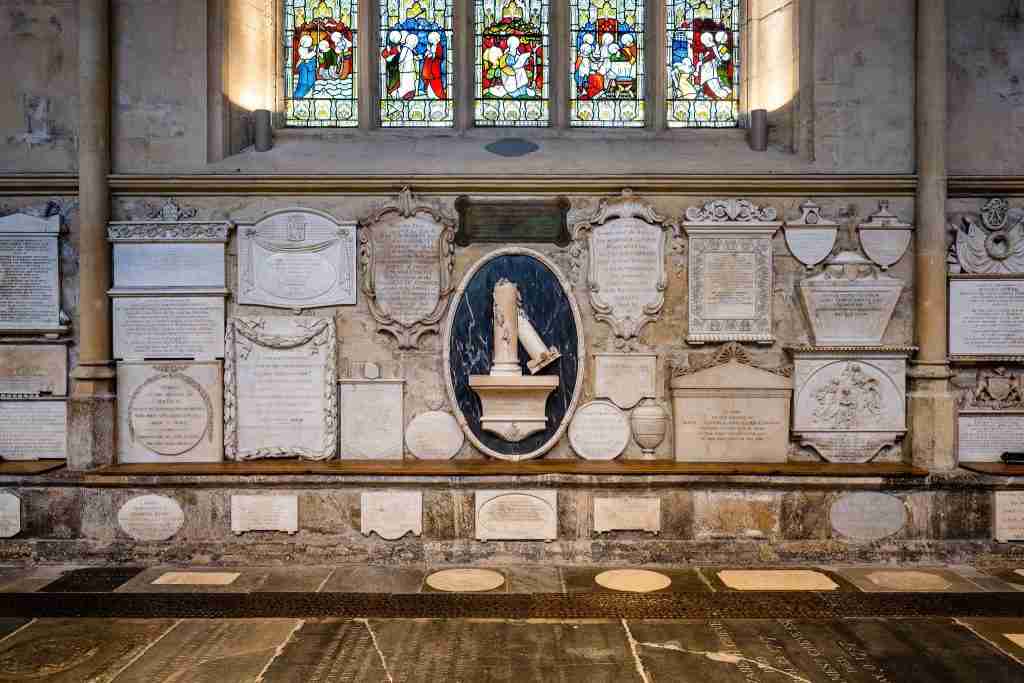Bath Abbey launches a new website containing details of its memorials: www.bathabbeymemorials.org.uk.
Bath Abbey has more commemorative wall tablets and gravestones than probably any other church in England, almost 1500 in total. Spanning the 16th to the 20th centuries, the life stories they tell are a fascinating part of its rich history.
The website is the result of 8 years of research by Bath Abbey’s archive team of staff and volunteers which was carried out as part of the Footprint Project, funded largely by the National Lottery Heritage Fund.
The comprehensive new database on the website will enable the public to find out more about the wide range of people connected to the Abbey. It’s possible to search in a variety of ways including name, age, profession, dates of birth and death. There are also transcripts of the inscriptions on the memorials, translated from Latin or modernised. Helpful location maps show where specific memorials are located inside the Abbey.
Many of the names have been researched in depth for the first time by our volunteers, which has resulted in some intriguing life-stories being uncovered. For example:
- William Oliver (d. 1716), who was an army surgeon and involved in the Duke of Monmouth’s failed rebellion against King James II in 1685.
- Ann Partis (d.1846), whose husband left her a large fortune. She established an alms house for gentlewomen in 1825 called Partis College in Bath. Today, it continues to provide housing for retired women.
- Sarah Crowden (1805-1900), who was a schoolmistress at Bath’s Blue Coat School in Sawclose (now the site of the ‘Giggling Squid’ restaurant) for over 50 years.
www.bathabbeymemorials.org.uk will be an important resource for historians, family ancestry researchers, teachers, heritage organisations and more. It will add to the existing pool of knowledge on Bath’s society in the Georgian and Victorian periods, a time of great growth and success for the city. The people who have been memorialised come from a wide range of backgrounds, perhaps even wider than might be expected, due to the popularity of the city as a fashionable spa destination. Many who arrived to live in Bath, or came seeking a cure for illness, died here and were buried under the Abbey’s floor or more recently in the Abbey’s cemetery. Relatives then paid the Abbey for permission to erect memorials to them.
As a result, the website includes some famous names such as Richard ‘Beau’ Nash (1674-1761), Bath’s Master of Ceremonies and Admiral Arthur Philip (1738-1814), first governor of the colony of New South Wales, Australia.
Colonial connections:
Out of the 1500 memorials, at least 200 relate to the British Empire and colonialism from the 1600s onwards. This means that the wall tablets or ledgerstones we see in the Abbey today were sometimes paid for from profits made through the suffering and exploitation of enslaved people.
One example is Hannah Alleyne (c.1727-1762) who was part of a large multi-generational family of plantation owners in Barbados. Her husband Thomas owned two plantations totalling 370 acres with 168 enslaved people forcibly working on them. Her son John became a lawyer and abolitionist who worked on the case known as the Mansfield Judgement (1772) which ruled that it was illegal to take an enslaved person out of England by force and sell them.
The Abbey deeply regrets this part of its history, and all human exploitation and racism, past and present. Along with the whole Church of England, we apologise unreservedly for having condoned or sustained the transatlantic slave trade, in any way whatsoever.
The Monumental Lives team of staff and volunteers is aware of the sensitivity of this subject matter and have taken responsibility to acknowledge and address this history through educating ourselves by undergoing diversity and inclusion training by Renée Jacobs, founder of The Belonging Network.
We have also consulted with Lisa Kennedy, an independent writer and researcher who advocates for the inclusion of wider perspectives within museums and the study of history. Lisa has edited and advised us on the use of appropriate language in the biographies of some of the people connected to colonialism, with the intention to actively acknowledge and address this history. We have followed her recent guidance, ‘Finding the Words: addressing language in archive collections.’
Bath Abbey is still in the process of learning how to communicate our colonial connections and is committed to consulting widely to ensure this is done in a fair and just way. We work with partners to promote racial equality and are committed to delivering the Church of England’s action plan ‘From Lament to Action’, to tackle institutional racism and reveal the historic links between the church and slavery.
Lisa Kennedy said,
“Working with the team from Bath Abbey has shown the power of collaboration in acknowledging and addressing the history of enslavement and colonialism. Through this research process, we were able to build on the understanding that the wealth creation within Bath has direct links to profits gained from violence and exploitation, in an attempt to provide a more holistic overview of this history.”
Revd Canon Guy Bridgewater, Rector of Bath Abbey, commented,
“The website is a result of many years of painstaking research by staff and volunteers. It provides a wealth of fascinating information on those congregation members memorialised on our walls and floors which I’m sure will be of great interest to a wide audience. We are committed to continuing to share information on the Abbey’s historic colonial connections, for example, and learn from them in order to help support work for racial equality today.”


